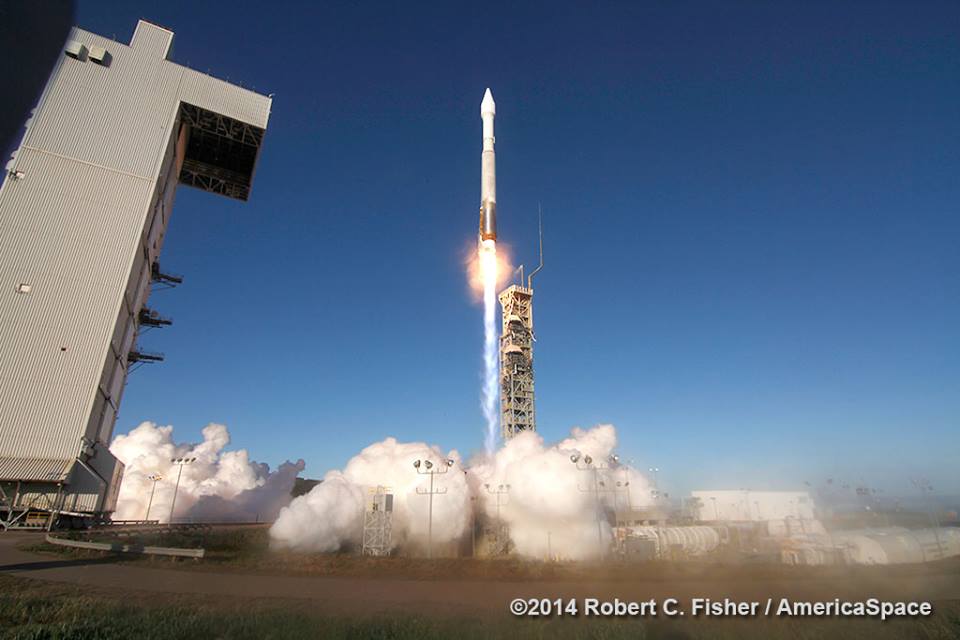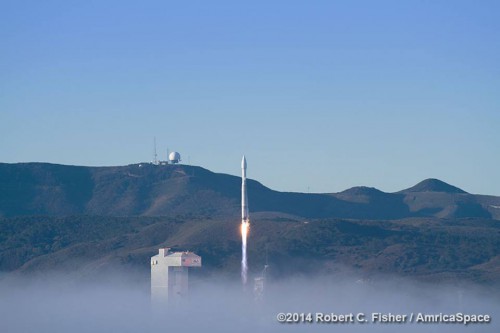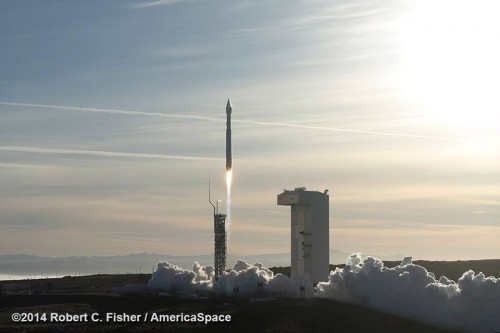
United Launch Alliance (ULA) has successfully staged its 80th mission since the company was formed in December 2006. Liftoff of the venerable Atlas V booster—flying in its “401” configuration, with a 13-foot-diameter (four-meter) payload fairing, no strap-on solid-fueled rockets, and a single-engine Centaur upper stage—took place on time at 7:46:30 a.m. PDT Thursday from Space Launch Complex (SLC)-3E at Vandenberg Air Force Base, Calif. Within 18 minutes, the vehicle had injected the 19th Defense Meteorological Satellite Program (DMSP) spacecraft into a near-polar, Sun-synchronous orbit of about 460 nautical miles (850 km). It will join a network of satellites whose heritage extends over five decades and which provides strategic and tactical weather prediction to aid the U.S. military in planning operations at sea, on land, and in the air.
Eighty launches in a little more than seven years is an impressive accomplishment for ULA, which was formed on 1 December 2006 as part of a merger between Boeing and Lockheed Martin. Plans to form the new company had been announced in May 2005, and, although the venture was initially challenged by SpaceX—which criticized its anti-trust legality in terms of launch services monopoly—it nevertheless received staunch support from the Department of Defense and was cleared by the Federal Trade Commission in September 2006. The company staged its first launch less than two weeks after it officially came into being, with the 14 December 2006 flight of a Delta II rocket from Vandenberg. This mission inserted the USA-193 reconnaissance satellite into orbit.

Three months later, in March 2007, ULA despatched its first Atlas V mission from Cape Canaveral Air Force Station, Fla., and the following November it flew its first Delta IV. All told, including today’s launch, the company has flown 36 Atlas Vs, 26 Delta IIs, and 18 Delta IVs. Aboard the Atlas, payloads have included Landsat 8, NASA’s Juno spacecraft to Jupiter, and the Mars Science Laboratory (MSL) with the Curiosity rover. Meanwhile, Delta IVs have delivered a wide range of reconnaissance satellites, weather satellites, military communications satellites, and early warning satellites into orbit, with the Delta II having logged the launches of NASA’s Phoenix mission to Mars, the Dawn asteroid explorer, and the Kepler extrasolar planet-hunter in its overflowing success record book. None of the 80 missions have produced a launch failure, although an Atlas V experienced a Centaur glitch in June 2007 and a Delta IV suffered a problematic launch in October 2012. As for the Delta II, it is one of the most reliable U.S. launch vehicles currently in active operational service. Although it has not flown since October 2011, it is slated to loft NASA’s Orbiting Carbon Observatory (OCO)-2 in July 2014.
Today’s mission was also the third ULA flight of 2014, following January’s launch of TDRS-L and February’s launch of GPS IIF-5. Both of these flights originated from Cape Canaveral Air Force Station, Fla., making today’s mission the first ULA mission from Vandenberg in 2014. Weather conditions at the California launch site were near-perfect, with meteorologists predicting between 90-100 percent favorable conditions at launch time. The Mobile Launch Platform (MLP), bearing the 196-foot-tall (60-meter) Atlas V, left the giant Vertical Integration Facility (VIF) at T-8 hours and was “hard-down” on the SLC-3E pad surface within an hour.
At T-2 hours, a 30-minute built-in hold began, ahead of loading propellants aboard the vehicle. At this stage, all stations were polled for their readiness to support the launch and produced a unanimous “Go for Launch.” This allowed for permission to be granted to begin pumping liquid oxygen into the Centaur upper stage. Meanwhile, the three-stage operation of fueling the Atlas’ Common Core Booster (CCB) with liquid oxygen and a highly refined form of rocket-grade kerosene (known as “RP-1”) also got underway, proceeding through its Slow Fill, Fast Fill, and Topping modes. The last propellant to be loaded was liquid hydrogen into the Centaur, which was at Topping level by T-40 minutes.

With all tanks confirmed at flight levels, the final checkout of the Flight Termination System (FTS)—tasked with destroying the vehicle in the event of a major, off-nominal event during the climb to orbit—was performed and ascent software, based upon the real-time weather situation, was updated. The Atlas V transitioned to internal power, and, 60 seconds ahead of liftoff, the Launch Control System was enabled and the Atlas’ computers assumed primary command of all critical functions.
Two and a half seconds ahead of liftoff, the first stage’s Russian RD-180 engine—with a propulsive yield of 860,000 pounds (390,000 kg)—roared to life, and climb-out from SLC-3E occurred at T+1.1 seconds. Shortly after clearing the tower, the Atlas executed a combined pitch, roll, and yaw program maneuver, which positioned it onto the proper 186.4-degree flight azimuth for the insertion of the DMSP-19 payload into orbit. According to ULA’s mission brochure, the mission followed a near-south trajectory, for emplacement into a near-polar, Sun-synchronous orbit. Ascent and mission telemetry were gathered by stations at Vandenberg (the Western Range), Diego Garcia in the Indian Ocean, Thule in Greenland, and RAF Oakhanger in the United Kingdom.
Eighty-three seconds into the flight, with the RD-180 still burning hot and hard, the vehicle burst through the sound barrier. At around this time, the maximum aerodynamic stresses (known as “Max Q”) were felt through the Atlas’ airframe. In response to this aerodynamic situation, the RD-180 was temporarily throttled back to 95 percent of its rated performance. “Guidance steering is enabled approximately 120 seconds into flight,” noted ULA in its brochure for the TDRS-L mission, also flown aboard an Atlas V 401. “At 212 seconds, the vehicle throttles up to a constant 5.0 G-level. Approximately 10 seconds prior to Booster Engine Cutoff (BECO), the Atlas V throttles down to a constant 4.6 Gs.” This final throttling-down of the RD-180 occurred at T+4 minutes and 22 seconds, and, after separation, the turn came for the Centaur upper stage, which carried the key responsibility for delivering DMSP-19 into geostationary transfer orbit.
At T+4 minutes and 30 seconds, the Centaur/DMSP-19 combo separated from the Atlas and its Pratt & Whitney Rocketdyne-built RL-10A engine roared to life for Main Engine Start (MES)-1. Eight seconds after the ignition of the engine, the huge, two-piece payload fairing encapsulating DMSP-19 was jettisoned, exposing it to the near-vacuum of space for the first time. The RL-10A engine then provided 25,000 pounds (11,340 kg) of thrust in a vacuum to complete the climb into orbit. The engine has the capacity for multiple restarts, although Thursday’s mission required a single “burn” to inject its payload into orbit.

“Approximately 16 minutes into the mission,” noted ULA’s mission brochure, “the first Centaur main engine cut-off (MECO-1) occurs, followed by the release of the DMSP-19 satellite at approximately 18 minutes and 28 seconds after liftoff.” At the point of payload separation, which occurred at 8:05 a.m. PDT, the DMSP-19 satellite resided in a near-circular orbit at an altitude of 460 nautical miles (850 km), inclined 98.814 degrees.
“Congratulations to the Air Force and all of our mission partners on this morning’s successful launch of DMSP-19,” said Jim Sponnick, ULA’s vice president of Atlas and Delta Programs. “ULA takes tremendous pride in the national capabilities we place on orbit for our customers and in the critical information that satellites such as DMSP provide to military and civilian users worldwide.” He added that “Achieving on-time launches for our customer’s missions with 100 percent mission success is a testament to this strong government and industry team being singularly focused on one launch at a time.”
DMSP-19, officially designed “Block 5D3 Flight 19,” arrived at Vandenberg in early August 2013, having been transported aboard an Air Force C-17 Globemaster III aircraft from Sunnyvale, Calif. This was the second DMSP launch atop an Atlas V 401, following the 5D3 Flight 18 mission in October 2009.
Operated by the Air Force Space and Missile Systems Center (SMC) on behalf of the Department of Defense, the DMSP program is focused upon the meteorological, oceanographic, and solar-terrestrial physics environments. Each of its satellites operates from a 101-minute-period, Sun-synchronous, near-polar orbit and carries a battery of visible and infrared sensors to collect images across a 1,860-mile (3,000-km) swath. This enables the system to provide global coverage twice daily, and its combination of three “day/night” satellites and one “dawn/dusk” satellite allows for the monitoring of global patterns, such as clouds, every six hours. The DMSPs can also observe environmental features such as bodies of water, snow, fires, and areas of pollution at visual and infrared wavelengths. Their data can be used to determine cloud type and height, land and surface water temperatures, sea currents, ocean surface features, ice, and snow.
Want to keep up-to-date with all things space? Be sure to “Like” AmericaSpace on Facebook and follow us on Twitter: @AmericaSpace



